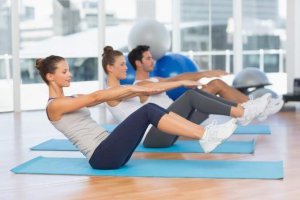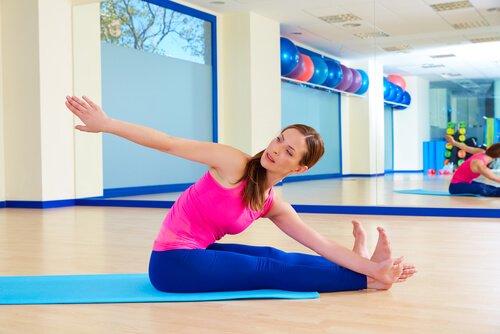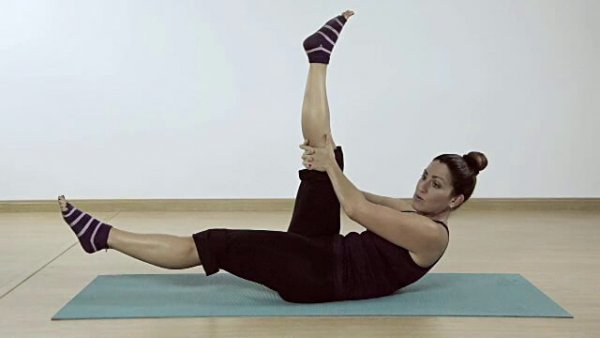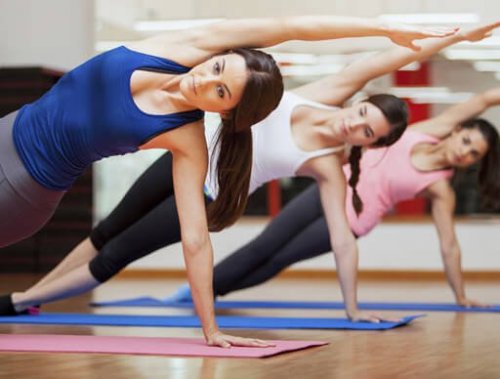5 Pilates Exercises for Beginners

Living in a stressful and hyper-connected world has made physical activity essential for well-being. Physical activity helps us relax, allows us to meet new people, and makes us produce adrenaline. In this regard, Pilates exercises for beginners are simple tools that can help us feel at peace.
Joseph Hubertus Pilates, a German coach, developed this practice in the early 20th century. He originally named it “Contrology” and described it as “The art and science of coordinating mind, body, and spirit through natural motions under strict conscious control”. For him, using your mind to control your body was really important.
The benefits we can get from Pilates are only comparable to those we can get from yoga. However, Pilates is more physically demanding. It helps you coordinate your breathing and promotes mind and body relaxation.
If you’ve never tried Pilates before, don’t freak out. The following Pilates exercises for beginners are very simple and will allow you to discover everything it has to offer you. After a couple of days, you’ll realize you were definitely missing out!
5 Pilates exercises for beginners
In the next section, we’re going to show you how to do some of the most recommended Pilates exercises for beginners:
The Saw
This exercise is perfect for strengthening your waist.
- First, sit down on the floor (or on a mat if you prefer) with your legs and arms open as wide as your hips.
- Once you’re in this position, take a deep breath and turn your upper body so that your right arm touches your left foot.
- Then, slowly shift and do the same on the other side.
- Repeat 4 or 5 times and then relax.
Remember to keep your back as straight as possible and don’t push yourself too hard. Be careful or you could hurt yourself!

The Roll Up
The Roll Up is one of the easiest Pilates exercises for beginners. The only thing you have to do is sit on your mat with your legs straight in front of you. Then, try touching your ankles with your hands. Maintain this position for 10-15 seconds and then relax. Just like with the previous exercise, don’t push yourself too hard. If you feel any pain or abnormal pull in your muscles, take a break and try again later.
“Change happens through movement and movement heals.”
-Joseph Pilates-
Scissors
- Lie down with your face towards the ceiling.
- Straighten your legs as much as you can and make a 90º angle with them.
- Grab one of them and pull it towards you, then switch.
- Repeat 10-15 times with each leg to tone both your legs and your spine.
Always try to do this exercise on an even surface in order to prevent lower back injuries.

Rolling Back
- Lie down on your mat and hug your legs towards your body.
- Then, start rocking your body back and forth, as if you were a little kid again.
- For this exercise, be mindful of your breathing, inhaling and exhaling at a regular rhythm. To do so, inhale when your back touches the ground and exhale when you return to the starting position.
Don’t feel like you can only do this exercise at the gym. You can also try it out in places like your room, the countryside, or the beach!
Side Bend
Out of the Pilates exercises for beginners, this is the one that focuses on balance the most. Again, lie down with your face towards the ceiling and reach up with your arms and legs at the same time. Try to create a 90º degree angle and balance yourself on your hip bones.

In the meantime, your head should always look towards your chest and you should exhale whenever your body is in an upright position. Again, be mindful of your back and joints to avoid injury.
In Pilates, one of the most important elements is your breathing. This is true because it’s what sets Pilates apart from other similar practices. Without a mindful and controlled breathing technique, you would only be doing stretches, and the exercises wouldn’t work as much. What’s more, it’s crucial to remember that Pilates is based on 7 basic principles:
- Precision
- Flowing
- Control
- Breath
- Centering
- Alignment
- Concentration
To see results, you need to take into consideration all seven principles. If one fails, so will all the others. Because of this, it’s advisable that you begin your Pilates journey next to an expert, as they’ll be able to guide you.
Once you become immersed in the Pilates practice and become more comfortable with it, you’ll be able to practice it on your own. Pilates is not just a workout: it’s a way of life. Use it to find peace and serenity. Give this discipline a chance and enjoy its many benefits!
Living in a stressful and hyper-connected world has made physical activity essential for well-being. Physical activity helps us relax, allows us to meet new people, and makes us produce adrenaline. In this regard, Pilates exercises for beginners are simple tools that can help us feel at peace.
Joseph Hubertus Pilates, a German coach, developed this practice in the early 20th century. He originally named it “Contrology” and described it as “The art and science of coordinating mind, body, and spirit through natural motions under strict conscious control”. For him, using your mind to control your body was really important.
The benefits we can get from Pilates are only comparable to those we can get from yoga. However, Pilates is more physically demanding. It helps you coordinate your breathing and promotes mind and body relaxation.
If you’ve never tried Pilates before, don’t freak out. The following Pilates exercises for beginners are very simple and will allow you to discover everything it has to offer you. After a couple of days, you’ll realize you were definitely missing out!
5 Pilates exercises for beginners
In the next section, we’re going to show you how to do some of the most recommended Pilates exercises for beginners:
The Saw
This exercise is perfect for strengthening your waist.
- First, sit down on the floor (or on a mat if you prefer) with your legs and arms open as wide as your hips.
- Once you’re in this position, take a deep breath and turn your upper body so that your right arm touches your left foot.
- Then, slowly shift and do the same on the other side.
- Repeat 4 or 5 times and then relax.
Remember to keep your back as straight as possible and don’t push yourself too hard. Be careful or you could hurt yourself!

The Roll Up
The Roll Up is one of the easiest Pilates exercises for beginners. The only thing you have to do is sit on your mat with your legs straight in front of you. Then, try touching your ankles with your hands. Maintain this position for 10-15 seconds and then relax. Just like with the previous exercise, don’t push yourself too hard. If you feel any pain or abnormal pull in your muscles, take a break and try again later.
“Change happens through movement and movement heals.”
-Joseph Pilates-
Scissors
- Lie down with your face towards the ceiling.
- Straighten your legs as much as you can and make a 90º angle with them.
- Grab one of them and pull it towards you, then switch.
- Repeat 10-15 times with each leg to tone both your legs and your spine.
Always try to do this exercise on an even surface in order to prevent lower back injuries.

Rolling Back
- Lie down on your mat and hug your legs towards your body.
- Then, start rocking your body back and forth, as if you were a little kid again.
- For this exercise, be mindful of your breathing, inhaling and exhaling at a regular rhythm. To do so, inhale when your back touches the ground and exhale when you return to the starting position.
Don’t feel like you can only do this exercise at the gym. You can also try it out in places like your room, the countryside, or the beach!
Side Bend
Out of the Pilates exercises for beginners, this is the one that focuses on balance the most. Again, lie down with your face towards the ceiling and reach up with your arms and legs at the same time. Try to create a 90º degree angle and balance yourself on your hip bones.

In the meantime, your head should always look towards your chest and you should exhale whenever your body is in an upright position. Again, be mindful of your back and joints to avoid injury.
In Pilates, one of the most important elements is your breathing. This is true because it’s what sets Pilates apart from other similar practices. Without a mindful and controlled breathing technique, you would only be doing stretches, and the exercises wouldn’t work as much. What’s more, it’s crucial to remember that Pilates is based on 7 basic principles:
- Precision
- Flowing
- Control
- Breath
- Centering
- Alignment
- Concentration
To see results, you need to take into consideration all seven principles. If one fails, so will all the others. Because of this, it’s advisable that you begin your Pilates journey next to an expert, as they’ll be able to guide you.
Once you become immersed in the Pilates practice and become more comfortable with it, you’ll be able to practice it on your own. Pilates is not just a workout: it’s a way of life. Use it to find peace and serenity. Give this discipline a chance and enjoy its many benefits!
All cited sources were thoroughly reviewed by our team to ensure their quality, reliability, currency, and validity. The bibliography of this article was considered reliable and of academic or scientific accuracy.
- Hernández-García, R., Rodríguez-Díaz, L., Molina-Torres, G., & Torres-Luque, G. (2018). Efectos de un programa de actividad física con el método pilates sobre la funcionalidad de mujeres embarazadas. Estudio piloto. Revista Iberoamericana de Ciencias de la Actividad Física y el Deporte, 7(2), 40-52.
- Vaquero-Cristóbal, R., Alacid, F., Esparza-Ros, F., Muyor, J. M., & López-Miñarro, P. Á. (2015). Efectos de un programa de 16 semanas de Pilates mat sobre las variables antropométricas y la composición corporal en mujeres adultas activas tras un corto proceso de desentrenamiento. Nutrición Hospitalaria, 31(4), 1738-1747.
- Vilella, S. B., Zarceño, E. L., & Rosa, M. Á. S. (2017). Salud psicosocial en trabajadores que practican Pilates: un estudio descriptivo-comparativo. Cultura, Ciencia y Deporte, 12(34), 27-37.
This text is provided for informational purposes only and does not replace consultation with a professional. If in doubt, consult your specialist.







